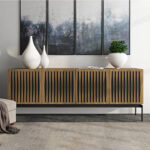Furniture design is constantly evolving, with trends shifting and changing as designers push the boundaries of traditional styles and materials. In recent years, there has been a surge in innovative trends in contemporary furniture, with a focus on sustainability, functionality, and modern aesthetics. From modular design to sustainable materials, let’s explore some of the most exciting trends in contemporary furniture.
One of the most prominent trends in contemporary furniture design is the use of modular and customizable pieces. Modular furniture allows for greater flexibility and versatility, as pieces can be rearranged and combined in a variety of configurations to suit different spaces and needs. This trend has been particularly popular in smaller living spaces, where every inch of space is precious. By offering modular furniture options, designers are able to cater to the needs of modern homeowners who are looking for furniture that is both stylish and practical.
Sustainability is another key trend in contemporary furniture design, with a growing emphasis on using eco-friendly materials and production methods. Designers are increasingly opting for sustainable materials such as reclaimed wood, bamboo, and recycled plastic in their furniture designs. Additionally, many furniture companies are adopting environmentally-friendly practices throughout the manufacturing process, from sourcing materials to reducing waste and energy consumption. By prioritizing sustainability, designers are not only creating furniture that is better for the planet but also for consumers who are increasingly conscious of their environmental impact.
Functionality is also a major focus in contemporary furniture design, with designers prioritizing pieces that are not only aesthetically pleasing but also practical and efficient. Multifunctional furniture pieces, such as sofa beds, storage ottomans, and extendable dining tables, are becoming increasingly popular as people look for ways to maximize space and functionality in their homes. This trend reflects the shifting needs of modern homeowners who are seeking furniture that can adapt to their changing lifestyles and living arrangements.
In terms of aesthetics, contemporary furniture design is characterized by clean lines, minimalistic shapes, and a focus on sleek, modern finishes. Neutral color palettes, such as whites, greys, and blacks, are commonly used in contemporary furniture design to create a sense of sophistication and timelessness. However, designers are also incorporating bold colors and unconventional materials to add a touch of personality and uniqueness to their pieces.
Overall, the world of contemporary furniture design is vibrant and ever-changing, with designers constantly pushing the boundaries of what is possible. By embracing trends such as modularity, sustainability, functionality, and modern aesthetics, contemporary furniture designers are creating pieces that are not only beautiful and stylish but also practical and environmentally-friendly. As consumers continue to demand furniture that is both innovative and sustainable, we can expect to see even more exciting trends emerge in the world of contemporary furniture in the years to come.




















